In the realm of modern architecture, the choice of building materials plays a pivotal role in defining the essence of a structure. Among these materials, white slabs have emerged as a symbol of purity, minimalism, and elevated design. Their use in exterior designs not only enhances the aesthetic appeal but also resonates with the surrounding environment, creating a harmonious blend of art and nature.




| Architects | https://katsufumikubota.jp/ |
| Images | KATSU TANAKA |
White Slabs: The Canvas of Modernity
White slabs serve as the foundation of contemporary design, offering architects a neutral palette upon which to project their visions. Their pristine nature allows for a seamless integration into various architectural styles, making them a favorite choice for many.
The beauty of white slabs lies in their simplicity. They don’t overshadow but rather complement the design elements. This balance ensures that every feature, from the smallest window to the grandest entrance, gets its moment in the spotlight.
In urban landscapes where chaos often reigns, the calming presence of white slabs brings a sense of order and tranquility. Amidst the hustle and bustle, these slabs stand as a testament to the timeless appeal of minimalism.
Furthermore, the durability of white slabs ensures that the exterior remains as stunning as the day it was built. This longevity, combined with their undeniable aesthetic appeal, makes them an invaluable asset in modern architecture.
Lastly, the reflective nature of white slabs plays with light in enchanting ways. Sunrises become more vibrant, and sunsets linger on these surfaces, casting mesmerizing patterns and turning ordinary buildings into extraordinary landmarks.



Elevated Architecture: Rising Above the Ordinary
Elevated architecture is about transcending the mundane. It’s about creating structures that don’t just serve a purpose but also inspire. With white slabs, architects have the perfect material to craft such awe-inspiring edifices.
The elevation in architecture is not just physical but also metaphorical. White slabs, with their ethereal beauty, elevate a building’s design, making it a beacon of modernity amidst traditional structures.
One of the challenges of elevated architecture is ensuring stability without compromising on aesthetics. White slabs, known for their strength, provide the perfect solution. They offer the robustness required for tall structures while maintaining the design’s elegance.
Moreover, elevated structures need to stand out. They need to be visible from a distance and leave a lasting impression. The gleaming white slabs catch the eye, ensuring that the building remains etched in memory long after one has passed it.
In conclusion, the use of white slabs in elevated architecture is not just a design choice; it’s a statement. It’s a declaration that the building is not just a structure but a work of art, worthy of admiration and awe.




Harmony with Nature: Blending with the Environment
White slabs, in their essence, are more than just building materials. They act as a bridge, connecting the man-made structures with the natural world around them. Their reflective nature captures the changing hues of the sky, making the building seem like a living entity that changes with the seasons.
In a world increasingly dominated by concrete jungles, it’s essential to have elements that remind us of nature. The white slabs, with their organic feel, do just that. They don’t clash with the greenery around but rather enhance it, creating a harmonious blend of nature and architecture.
Moreover, the thermal properties of white slabs make them an environmentally friendly choice. They reflect a significant amount of sunlight, ensuring that the building remains cool even during the hottest days. This natural temperature regulation reduces the reliance on artificial cooling, leading to energy conservation.
The minimalist appeal of white slabs also means lesser use of paints and other chemicals. This reduction in chemical usage is not only beneficial for the environment but also ensures healthier living spaces for the inhabitants.
Lastly, in an era where sustainable architecture is the need of the hour, white slabs prove to be invaluable. Their longevity ensures that there’s no frequent need for replacements, leading to lesser wastage of resources. Their natural compatibility with the environment around makes them a favorite for eco-friendly architectural projects.



The Future of Architecture: White Slabs Leading the Way
As we look towards the future of architecture, it’s evident that sustainability, aesthetics, and functionality will be the guiding principles. White slabs, with their myriad benefits, are perfectly poised to lead this architectural revolution.
The adaptability of white slabs ensures that they fit seamlessly into various architectural styles, from ultra-modern skyscrapers to quaint countryside homes. This versatility ensures that they remain relevant regardless of changing architectural trends.
Furthermore, as urban spaces become more cramped, the emphasis will shift to creating open, airy spaces that provide a respite from the chaos. The reflective nature of white slabs can make spaces seem larger than they are, making them perfect for such designs.
Innovation in architecture will also see a blend of indoor and outdoor spaces. White slabs, with their ability to harmonize with nature, will play a crucial role in creating such blended spaces. Their durability ensures that they can withstand the elements, making them perfect for both indoor and outdoor use.
In conclusion, as we stand on the brink of architectural innovations, white slabs are not just a part of the conversation; they are leading it. Their blend of aesthetics, functionality, and sustainability ensures that they will shape our buildings and, by extension, our future.


The journey of white slabs, from being mere building materials to becoming the heart of modern architecture, is truly inspiring. They encapsulate the essence of contemporary design – a blend of beauty, functionality, and sustainability. As we move forward, it’s clear that white slabs will continue to inspire, innovate, and elevate the world of architecture.












